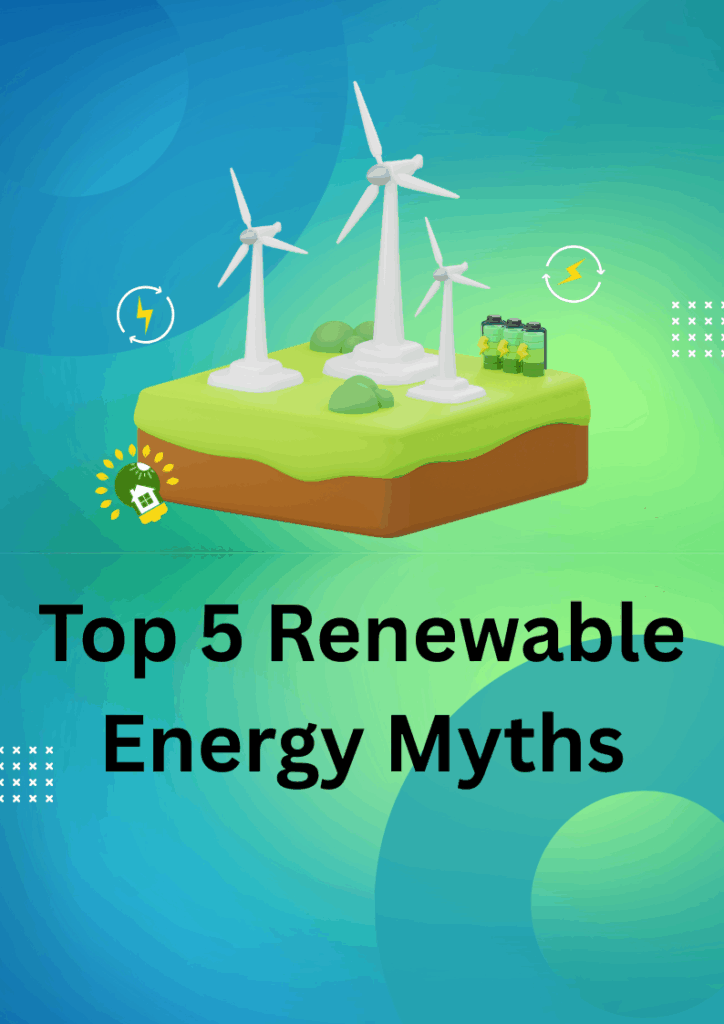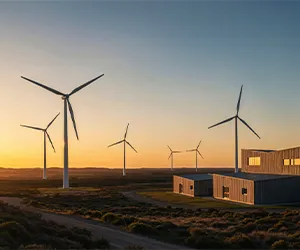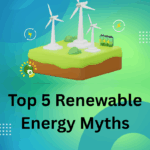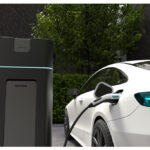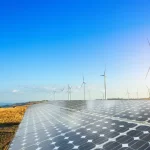Top 5 Renewable Energy Myths – Busted with Facts
In a world moving steadily toward sustainability, renewable energy has become a central part of conversations around climate change and environmental protection. Despite its growing presence, misconceptions and misinformation continue to cloud public perception. Whether it’s about wind turbines, solar panels, or battery storage, renewable energy myths often deter people from embracing clean alternatives.
Let’s separate the facts from fiction by busting the top 5 renewable energy myths. Get ready for some surprising insights — and maybe even a few fun facts about renewable energy along the way!
Myth 1: Renewable energy is unreliable because it only works when the sun shines or the wind blows
The Myth:
One of the most common renewable energy myths is that solar and wind power are too intermittent to be reliable sources of electricity.
The Reality:
While solar and wind are variable sources of energy, that does not necessarily mean they are unreliable. Technology has come a long way in terms of managing and storing renewable energy. Grid operators now employ sophisticated forecasting tools to accurately forecast solar and wind generation.
Furthermore, energy storage systems — particularly lithium-ion batteries — have revolutionized how we balance supply and demand. Contrary to lithium-ion battery charging myths, these batteries are highly efficient and capable of storing large amounts of energy for use during cloudy days or still nights.
Cool Fact about Renewable Energy: Tesla’s California Megapack lithium-ion battery is capable of powering 30,000 homes for four hours!
Aside from battery storage, renewable energy technologies are now coming together in richly varied energy grids that include hydropower, biomass, and geothermal power — offering an even mix of balance and dependability.
Myth 2: Wind turbines are noisy, dangerous to wildlife, and bad for your health
The Myth:
Opponents of wind energy often claim that turbines are noisy, pose health risks, and are harmful to birds and bats.
The Reality:
These issues are overstated or based on outmoded statistics. New wind turbines are considerably quieter than older ones, and they produce noise equal to that of a refrigerator from a distant perspective.
As for wildlife, it is correct that badly sited wind farms have had an impact on bird populations, but so do glass towers, cars, and even household cats. With good site selection and better turbine design, the sector has made considerable progress in avoiding these effects.
Wind energy myths and facts: Wind farms are less responsible for bird death than fossil fuel facilities, which emit toxins that kill birds and ecosystems.
There is no scientific basis for attributing wind turbines to negative health impacts such as headaches or “wind turbine syndrome.” These allegations have been examined and discredited by health agencies across the globe.
Myth 3: Renewable energy is too expensive to be practical
The Myth:
Many still believe that clean energy comes with a hefty price tag and is only viable for wealthy countries or large corporations.
The Reality:
This was true a decade ago, but today it’s one of the biggest renewable energy myths and facts to update. Solar and wind are now the cheapest sources of new electricity generation in many parts of the world.
According to the International Renewable Energy Agency (IRENA), the cost of solar power has dropped by over 85% in the last 10 years. Wind power costs have fallen by around 70% during the same period.
Fun Fact about Renewable Energy: In 2023, solar energy became cheaper than coal in India, one of the world’s largest coal consumers.
Additionally, governments around the world offer subsidies and tax incentives for adopting clean energy, making it accessible for homeowners and small businesses alike.
Myth 4: Lithium-ion batteries are unsafe and degrade quickly
The Myth:
There’s a common belief that lithium-ion batteries — the powerhouse of electric vehicles and renewable energy storage systems — are prone to catching fire and lose effectiveness quickly.
The Reality:
This is one of those lithium-ion battery charging myths that keeps resurfacing. While no battery is entirely risk-free, lithium-ion batteries are remarkably safe when manufactured and handled correctly. Incidents are extremely rare, and most are due to manufacturing defects or improper use.
As for battery degradation, technology has advanced significantly. Modern lithium-ion batteries used in grid storage and EVs can last over 10 years with minimal performance loss.
Proper charging practices, temperature control, and regular maintenance extend the life and safety of these batteries even further.
Fun Fact about Renewable Energy: Some electric vehicles using lithium-ion batteries have crossed 500,000 km without a battery replacement!
Battery recycling is also on the rise, with companies developing efficient methods to reclaim valuable materials like lithium, cobalt, and nickel, making the system more sustainable.
Myth 5: Renewable energy can’t support a modern industrial economy
The Myth:
Critics argue that while renewable energy might work for small-scale applications, it’s not capable of powering large-scale industries or urban infrastructure.
The Reality:
Not only is this out of date — it’s downright inaccurate. Denmark and Germany already produce large fractions of their electricity from renewables and have robust industrial economies to show for it.
Even in America, California and Texas are quickly ramping up wind and solar without dropping industrial production. With smart grids, distributed energy generation, and better storage, renewables can — and are — driving advanced economies.
In addition, commercially viable solar and wind farms are being constructed quicker and cheaper than conventional fossil fuel facilities.
Renewable energy myths and facts: Renewable energy contributed more than 80% of new power generation capacity globally in 2022.
Clean energy is not only possible — it’s necessary. As the climate goals become more stringent and fossil fuels run out, renewables provide the only sustainable, scalable solution.
Why Busting These Myths Matters
Falling for renewable energy myths isn’t just harmless misunderstanding — it can stall progress, policy change, and investment. The energy transition is happening now, and public perception plays a huge role in how fast (or slow) we move toward a cleaner future.
Educating ourselves with renewable energy myths and facts helps push back against lobbying efforts from non-renewable sectors and empowers individuals to make informed decisions.
Bonus Round: More Fun Facts About Renewable Energy
- A single wind turbine has the capability to produce electricity sufficient to light 1,500 houses in a year.
- The energy that the sun provides to the planet within one hour is greater than the one that humanity consumes during 12 months.
- In the future, tidal and wave energy can meet more than 10 percent of the total world electricity demand.
- Lithium-ion batteries are now incorporated in homes, schools, hospitals and even in planes.
- Solar roads are under testing in such countries as France, the Netherlands, and the U.S.
Final Thoughts
Renewable energy is more than just a buzzword. It’s a rapidly evolving solution to some of our biggest global challenges — climate change, pollution, and resource scarcity.
By debunking these renewable energy myths, we pave the way for a cleaner, smarter, and more equitable energy future. Whether you’re a policymaker, student, or simply a curious reader, knowing the renewable energy myths and facts equips you to be a more informed advocate for change.
And remember, the next time someone repeats one of these tired myths, you’ve got the facts to set the record straight — and maybe even surprise them with a fun fact about renewable energy or two!
Frequently Asked Questions (FAQs)
Understanding the real renewable energy myths and facts helps people make informed decisions, support green policies, and invest in a cleaner future. Myths delay adoption, innovation, and climate action.
Yes! With energy storage solutions like lithium-ion batteries, and a balanced energy mix including hydro and geothermal, renewable systems can supply power 24/7. This busts one of the most persistent renewable energy myths.
This is a frequently cited wind energy myth. While older turbines posed challenges, modern designs are much safer for birds and much quieter — emitting about the same noise as a kitchen refrigerator at 300 meters.
This is outdated information. Today, solar and wind are some of the cheapest forms of energy available. Technological improvements and economies of scale have driven costs down significantly.
Absolutely! For example, the energy from sunlight hitting Earth in one hour could power the entire planet for a year. Or, one wind turbine can power over 1,500 homes. These fun facts about renewable energy highlight its massive potential.

